- News
- Reviews
- Bikes
- Accessories
- Accessories - misc
- Computer mounts
- Bags
- Bar ends
- Bike bags & cases
- Bottle cages
- Bottles
- Cameras
- Car racks
- Child seats
- Computers
- Glasses
- GPS units
- Helmets
- Lights - front
- Lights - rear
- Lights - sets
- Locks
- Mirrors
- Mudguards
- Racks
- Pumps & CO2 inflators
- Puncture kits
- Reflectives
- Smart watches
- Stands and racks
- Trailers
- Clothing
- Components
- Bar tape & grips
- Bottom brackets
- Brake & gear cables
- Brake & STI levers
- Brake pads & spares
- Brakes
- Cassettes & freewheels
- Chains
- Chainsets & chainrings
- Derailleurs - front
- Derailleurs - rear
- Forks
- Gear levers & shifters
- Groupsets
- Handlebars & extensions
- Headsets
- Hubs
- Inner tubes
- Pedals
- Quick releases & skewers
- Saddles
- Seatposts
- Stems
- Wheels
- Tyres
- Health, fitness and nutrition
- Tools and workshop
- Miscellaneous
- Tubeless valves
- Buyers Guides
- Features
- Forum
- Recommends
- Podcast
review
£1,649.00
VERDICT:
A swift and smooth ride for those who want an endurance bike with a racing slant
Weight:
8,500g
Contact:
At road.cc every product is thoroughly tested for as long as it takes to get a proper insight into how well it works. Our reviewers are experienced cyclists that we trust to be objective. While we strive to ensure that opinions expressed are backed up by facts, reviews are by their nature an informed opinion, not a definitive verdict. We don't intentionally try to break anything (except locks) but we do try to look for weak points in any design. The overall score is not just an average of the other scores: it reflects both a product's function and value – with value determined by how a product compares with items of similar spec, quality, and price.
What the road.cc scores meanGood scores are more common than bad, because fortunately good products are more common than bad.
- Exceptional
- Excellent
- Very Good
- Good
- Quite good
- Average
- Not so good
- Poor
- Bad
- Appalling
The Wilier GTR Team Endurance 105 is a quick and comfortable ride, striking a good balance between a traditional-style race bike and a relaxed-geometry sportive machine.
How does it ride?
The Wilier is more of a race bike than many others out there with an 'endurance' tag. How come? Well, it feels like a race bike when you crank up the power. Whereas some endurance bikes feel wallowy and low in energy, the GTR Team accelerates keenly and is solid at both the bottom bracket and the head tube when you lay it all on the line in a road sign sprint.
> Find your nearest dealer here
Weighing in at 8.5kg (18.7lb), this is a reasonably light bike for its type and price, and it climbs well, if not quite setting the slopes alight. The non-series (it doesn't belong to any groupset) Shimano R500 compact chainset (with 50 and 34-tooth chainrings) is matched with an 11-28 cassette; some endurance bikes go even lower, with an 11-32 cassette, but the Wilier's should give you all the gears you're likely to need to conquer the most sinister climbs on your toughest days in the saddle. The 34x28 combo might not get you up the hills as fast as a race bike's higher gears, but it will get you up there eventually, and sometimes that's what really counts.
It's a well-behaved descender too, obediently steering exactly where you want to go with minimal input and remaining unfazed when you hit the inevitable rough patches. The non-series Shimano dual-pivot brakes might have a heavier feel than the brand's higher end options, but they don't lack the power you need to stay in full control when slamming through the bends on somebody else's wheel.
Is it comfortable?
Despite having many of the characteristics of a traditional race bike, the Wilier provides a comfortable ride. Part of that is down to a geometry that's a little more relaxed than that of a full-on race machine.
There are two schools of thought when it comes to designing endurance bikes. Some brands bang a load of height on the head tube and shrink the top tube right back to create a very upright riding position. And then there's what you might call the Italian approach.
Most Italian brands (and, yes, this is a gross generalisation) tend to be far more conservative when it comes to endurance bike geometries. They'll adjust things so that the riding position is a smidgen more upright, but we're talking about tweaks rather than a wholesale redesign.
This is pretty much what Wilier has done. The new GTR Team, like the GTR SL (see below), has a geometry based on Wilier's Cento1 high-end race bike, but with about 10mm of extra height in the head tube. The brand's designers feel that it's better to add a little length to the head tube than to have most riders putting spacers underneath the stem to bring the handlebar up higher, and I'd certainly agree. It's a stiffer and neater solution.
As well as that, Wilier offers both the GTR Team and SL in two different geometries: race and endurance (again, see below). Ours is the endurance version.
The difference is in the fork. Wilier has added an extra 10mm into the crown of the endurance bike, and increased the offset (the distance the front axle sits ahead of the steering axis) from 45mm to 49mm. Like I said, these are subtle differences but they increase the stack height (the vertical distance from the centre of the bottom bracket to the top of the head tube), slacken the head angle, and lengthen the wheelbase.
I didn't feel that my body position was nearly as upright when riding this bike as it has been on many other endurance bikes. On the other hand, I wasn't as low or stretched as on a traditional-style race bike either. The riding position is somewhere in the middle. As ever, whether this is right for you will come down to your individual physiology and preference, but if you're looking for an endurance bike with a racy edge, this is a model that's worth considering.
As well as relaxing the riding position a touch, Wilier has managed to dial a decent amount of vibration damping into the GTR Team Endurance 105. Along with the 25mm Continental Ultra Sport tyres and FSA's slim 27.2mm diameter alloy seatpost, the frame filters out a lot of road irregularities and, believe me, we have a lot of those around here. You can certainly find bikes out there that offer plusher rides but there's a marked lack of road buzz with the GTR Team, and that's noticeable at both the handlebar and the saddle.
Speaking of the saddle, for me that's the one negative here when it comes to comfort. I just couldn't learn to love the Selle Italia X1. A couple of my favourite saddles are from Selle Italia but the X1 isn't quite wide/flat enough across the nose for me, and after just a few miles of each ride I felt like I was sitting on a ridge and needing to stand up on the pedals more often than I'd have liked. Still, saddles are always a matter of personal taste and you might get along with it just fine. The only way to find out for sure is to try it for yourself.
What about the other components?
The shifters and mechs are from Shimano's mid-level 105 groupset and they worked flawlessly throughout testing. They usually do. The groupset offers a fabulous performance for the money. It's 11-speed, light action, easy to operate from both the hoods and the drops... In short, it's excellent stuff. Go to our 105 groupset review for the full story.
As mentioned above, the R500 chainset doesn't belong to any groupset. It doesn't have the hollow crank arms of some Shimano chainsets, and it has a five-arm spider whereas 105, like Dura-Ace and Ultegra, has switched to a four-arm design and super-stiff chainrings. If you're feeling short-changed, it's a simple enough upgrade over time.
The Aksium wheels are Mavic's cheapest road option but don't let that put you off – the French brand just doesn't make entry-level wheels. The Aksiums use aluminium hub bodies, Mavic's very good QRM sealed cartridge bearings, and straight-pull spokes that, in our experience, are stronger than J-bend spokes. We've used these wheels countless times on various bikes and they've proven to be quick and reliable. They're a solid choice for a versatile bike like this.
The only components I've not yet mentioned are the Wilier-branded aluminium handlebar and stem from FSA, each of which puts in a workmanlike performance. The handlebar is compact so it's not too much of a stretch to get down to the drops, and plenty of rearward sweep makes for comfortable hand positioning.
Are there other build choices?
For those who want to stick with the Italian flavour of the frame, the GTR Team Endurance is also available in a Campagnolo Athena build with Campag Zonda wheels for £1,999.
The GTR Team is also available in a race geometry. The frame is exactly the same as the one we have here but the fork is 10mm shorter and with a smaller offset, so you get a slightly more aggressive riding position. That one comes with a Shimano Ultegra groupset and Mavic Aksium Elite wheels (a bit lighter than standard Aksiums because Mavic joins the two ends of the rim using a sleeve rather than a pinned joint) for £1,899.
> Check out our guide to some great endurance and sportive bikes for 2016 here
Wilier also offers the GTR SL in several builds. The SL frame comes out of the same mould as the GTR Team but it's made from different grades of carbon composite. The GTR Team is a blend of 46 ton and 30 ton carbon and has a claimed frame weight of 1,190g, while the GTR SL uses 60 ton and 46 ton carbon and has a claimed frame weight of 990g. GTR SL bikes start at £2,399 for the Shimano Ultegra model with Mavic Aksium Elite wheels.
On top of all those options, the GTR Team is available in two disc brake models. The cheaper of these is built up with a Shimano 105 groupset and DT Swiss R24 Spline wheels and is priced at £2,399. The more expensive model comes with a Shimano Ultegra groupset and the same wheels for £2,699.
Verdict
A swift and smooth ride for those who want an endurance bike with a racing slant
road.cc test report
Make and model: Wilier GTR Team Endurance 105
Size tested: XL
About the bike
State the frame and fork material and method of construction. List the components used to build up the bike.
Frame Full carbon monocoque
Forks Full carbon
Chainset Shimano RS500L, 50/34T
Bottom Bracket Shimano, Pressfit
Chain Shimano HG600
Front derailleur Shimano 105
Rear Derailleur Shimano 105
Shifters Shimano 105 11sp
Front Brake Shimano R561
Rear Brake Shimano R561
Headset FSA Integrated
Stem FSA OS190, aluminium
Handlebars FSA compact, aluminium
Saddle Selle Italia X1
Seatpost FSA SL-282, aluminium
Wheels Mavic Aksium
Tyres Continental Ultra-Sport, 700x25c
Tell us what the bike is for, and who it's aimed at. What do the manufacturers say about it? How does that compare to your own feelings about the bike?
Wilier says, "Whether you race or not, the GTR SL or GTR TEAM is aimed for the rider who needs a bike for multiple uses. Light and responsive for the racer, yet comfortable and versatile for those who enjoy cycling without stress. The GTR SL and GTR TEAM are identical in geometry and sizing, coming from the same carbon mold. They differ in the carbon composition: GTR SL uses a 60 ton / 46 ton carbon blend, to produce a frame weight of 990 grams. The GTR Team uses a 46 ton / 30 ton carbon blend, producing a frame weight of 1190 grams. Utilizing Wilier Triestina's carbon expertise, two frames can be offered with the same construction technologies but with a difference in weight, performance, and price."
It's a road bike for sports-type riding, be that races, sportives, training, or just getting the miles in.
Frame and fork
Overall rating for frame and fork
8/10
Tell us about the materials used in the frame and fork?
It's made from 46 ton/30 ton carbon composite.
Tell us about the geometry of the frame and fork?
It's somewhere between that of a traditional-style race bike and a more upright sportive bike. In typical Italian style, Wilier has relaxed the geometry just a little.
This is partly achieved by adding an extra 10mm of height to the fork crown. This brings the front end up a touch.
I've covered this in more detail in the main body of the review.
How was the bike in terms of height and reach? How did it compare to other bikes of the same stated size?
The sizing was about average. See above and in the body of the review for more on the height and reach.
Riding the bike
Was the bike comfortable to ride? Tell us how you felt about the ride quality.
I didn't get on especially well with the saddle, but apart from that I found this to be a comfortable bike both in terms of the riding position and the way in which it deals with bumps and vibration.
Did the bike feel stiff in the right places? Did any part of the bike feel too stiff or too flexible?
The centre of the frame felt stiff when I applied power – not absolutely rock solid, but strong.
How did the bike transfer power? Did it feel efficient?
Certainly efficient.
Was there any toe-clip overlap with the front wheel? If so, was it a problem?
None.
How would you describe the steering? Was it lively, neutral or unresponsive? On the lively side of neutral.
Tell us some more about the handling. How did the bike feel overall? Did it do particular things well or badly?
It didn't exactly sparkle on the climbs but it cracked into the work eagerly enough. It corners very well without much effort.
Which components had the most effect (good or bad) on the bike's comfort? would you recommend any changes?
I didn't get on particularly well with the saddle, but that's not to say it's a bad saddle, it just didn't suit me.
Rate the bike for efficiency of power transfer:
8/10
Rate the bike for acceleration:
7/10
Rate the bike for sprinting:
8/10
Rate the bike for high speed stability:
7/10
Rate the bike for cruising speed stability:
7/10
Rate the bike for low speed stability:
7/10
Rate the bike for cornering on descents:
8/10
Rate the bike for climbing:
7/10
The drivetrain
Rate the drivetrain for performance:
7/10
Rate the drivetrain for durability:
8/10
Rate the drivetrain for weight:
7/10
Rate the drivetrain for value:
8/10
Wheels and tyres
Rate the wheels and tyres for performance:
8/10
Rate the wheels and tyres for durability:
8/10
Rate the wheels and tyres for weight:
8/10
Rate the wheels and tyres for comfort:
8/10
Rate the wheels and tyres for value:
9/10
Controls
Rate the controls for performance:
9/10
Rate the controls for durability:
8/10
Rate the controls for weight:
8/10
Rate the controls for comfort:
9/10
Rate the controls for value:
9/10
Your summary
Did you enjoy riding the bike? Yes
Would you consider buying the bike? Perhaps
Would you recommend the bike to a friend? Yes
Rate the bike overall for performance:
7/10
Rate the bike overall for value:
8/10
Use this box to explain your score
This bike is definitely a 7 or an 8 overall. I'm not sure it does quite enough to warrant an 8, but it's a close-run thing.
About the tester
Age: 43
I usually ride: My best bike is:
I've been riding for: Over 20 years I ride: Most days I would class myself as: Expert
I regularly do the following types of riding: commuting, club rides, sportives, general fitness riding
Mat has been in cycling media since 1996, on titles including BikeRadar, Total Bike, Total Mountain Bike, What Mountain Bike and Mountain Biking UK, and he has been editor of 220 Triathlon and Cycling Plus. Mat has been road.cc technical editor for over a decade, testing bikes, fettling the latest kit, and trying out the most up-to-the-minute clothing. He has won his category in Ironman UK 70.3 and finished on the podium in both marathons he has run. Mat is a Cambridge graduate who did a post-grad in magazine journalism, and he is a winner of the Cycling Media Award for Specialist Online Writer. Now over 50, he's riding road and gravel bikes most days for fun and fitness rather than training for competitions.
Latest Comments
- Slartibartfast 32 min 52 sec ago
Might have to expand on this one a bit fella as it's hard to unpick exactly what your point is.
- hapaxlegomenon 3 hours 36 min ago
Caad12 / 13's don't have udh, which doesn't seem like a big deal right now. But wait for it
- mark1a 6 hours 22 min ago
Yep, my dad was a handler (wafu chockhead) in the Fleet Air Arm back in the 70s/80s/90s and he said the worst thing about when Top Gun came out in ...
- Sredlums 7 hours 1 min ago
"else much more people would get cancer" Err… what!? A huge amount of people DO get cancer 😑
- Sredlums 8 hours 41 min ago
Yeah, so you can zoom along, motor assisted, no sweat - until you reach 25Km/h and the motor assist stops and your riding mates leave you in the...
- cmedred 10 hours 24 min ago
Do you think the moto addicts of BCP worried about what "right" cyclists "have to tell anyone what to do on the roads'' ever ponder what "right"...
- mark1a 10 hours 27 min ago
It's a little reminiscent of the S-Works Tarmac that Trinity Racing rode in 2023.
- Gkam84 10 hours 34 min ago
It's a shame it never really took off, I used to play a lot and for a few seasons was helping to run the back end. It was a really enjoyable one...
































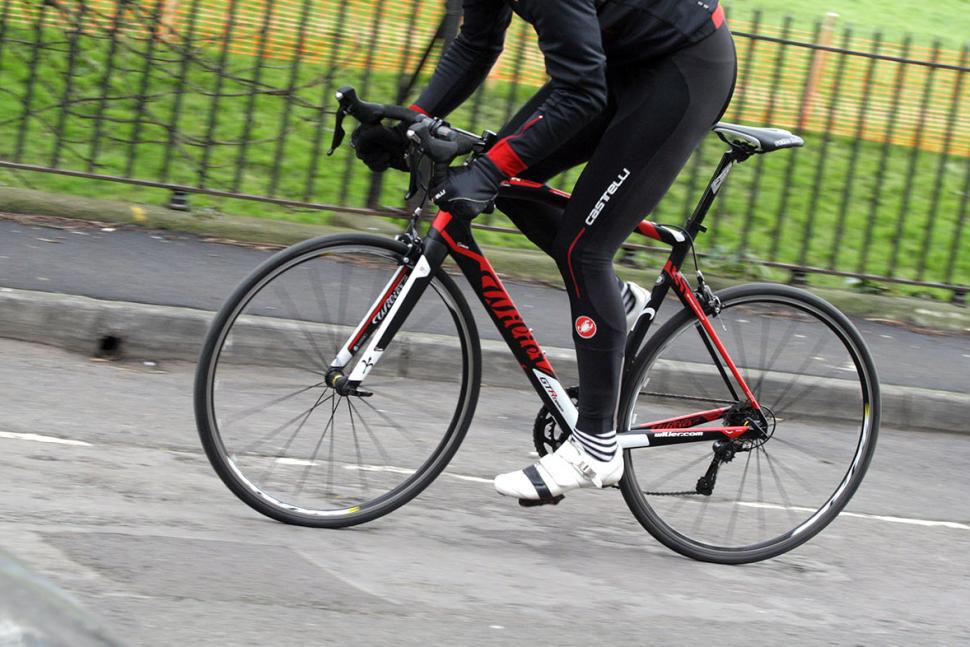


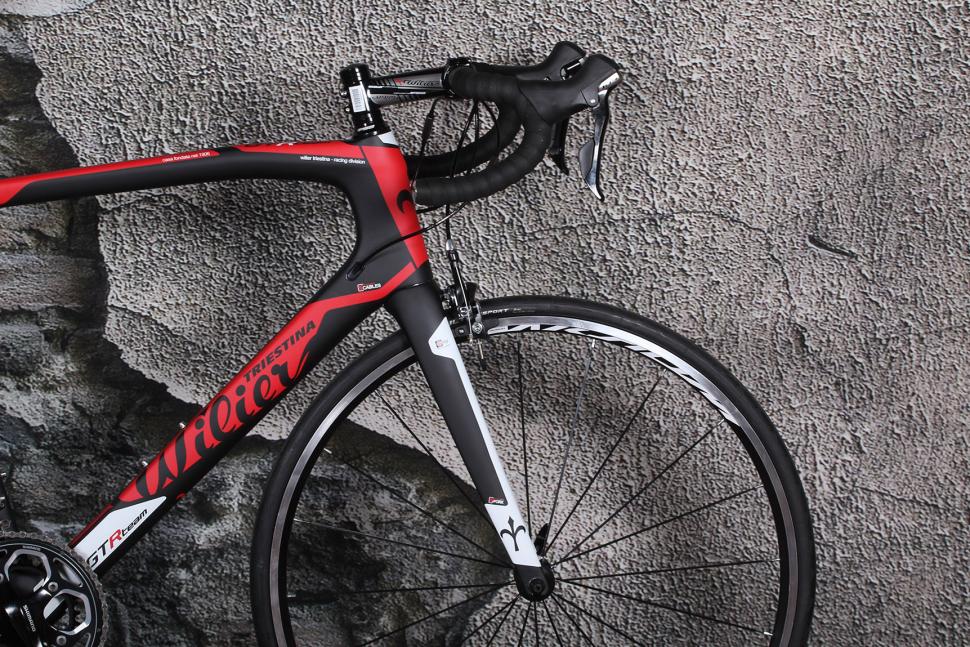




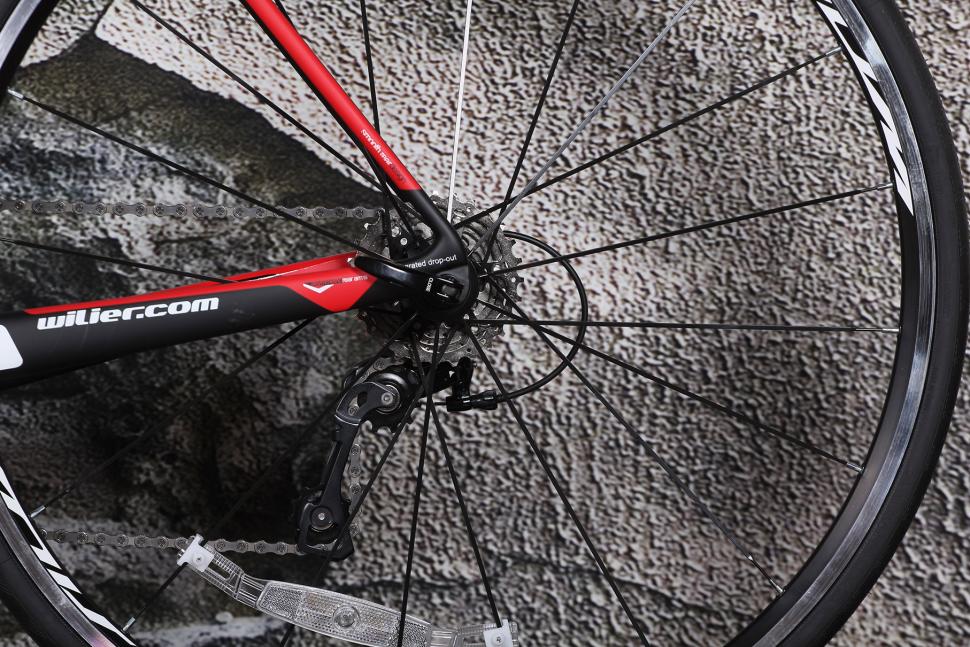

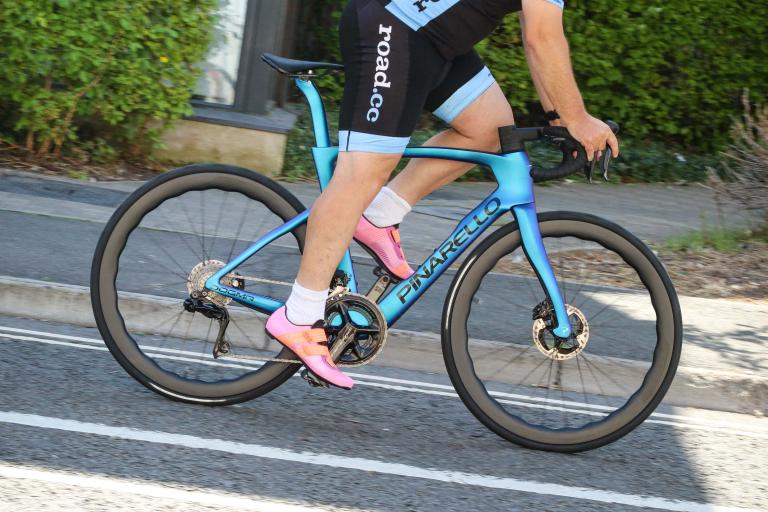

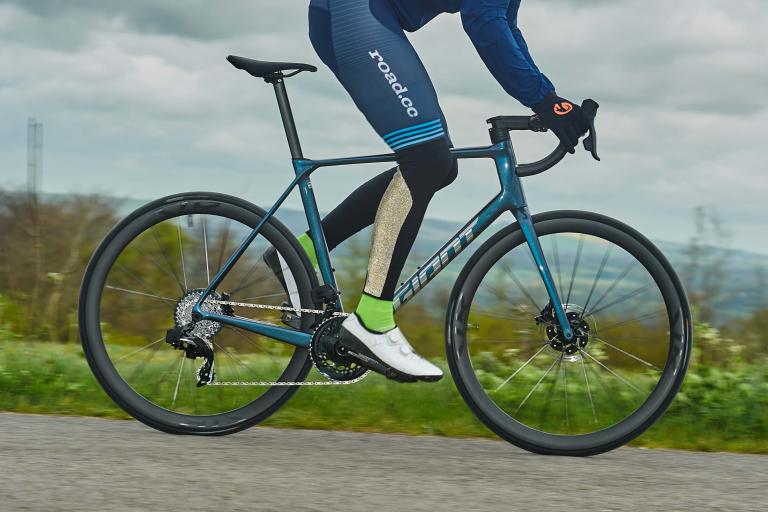
Add new comment
3 comments
Got to agree with nesfyl - bizzare comment by reviewer!
"The 34x28 combo might not get you up the hills as fast as a race bike's higher gears" I'm sorry but this is ridiculous - as if there are no higher gears on this bike after the 34x28. Unless you mean you routinely spin out the 50x11 'up the hills', in which case you have no business being a journalist.
The language is somewhat equivocal, but I think what he was trying to say is that 34x28 gives you a lower bailout gear that lets you plod up a steeper hill in a way a race bike's higher granny gear wouldn't. Assuming you won't or can't compensate with cadence, the point seems to be that if you riding in the granny you will likely ride slower but you can possibly do so on steeper terrain. Which makes some sense.
Although, for those who like to spin and use up the whole cassete, like me, this isn't always the case. I'm hitting about 7.5mph on my 34x32 @ 88rpm. Switch that to a 39x25 (or a similarly tall 50x32), and I'll just lower my cadence to around 60. Sustaining my cadence @ 88rpm would push me from 310W to 450W on a 7% pitch, which is not, well, a sustainable proposition at the moment. At least for all but the shortest of bumps. So I, for one, probably wouldn't be going any faster on "race bike gearing" on anything approaching a real hill. I'd just be grinding harder.
In any case, this seems like a good option for those who have yet to "warm up" to disc brakes. No need to panic, retro-grouches, nice comfortable carbon endurance rim-brake bikes are still in the pipeline.